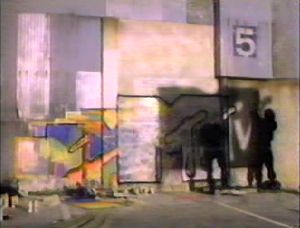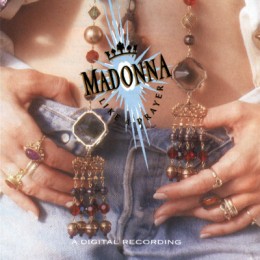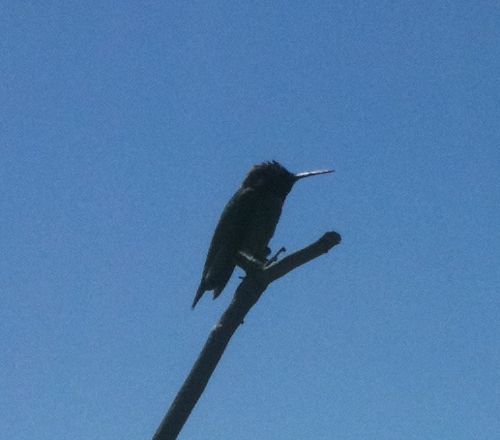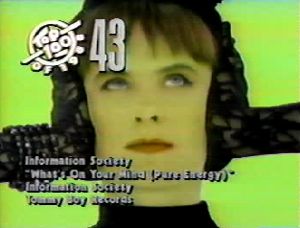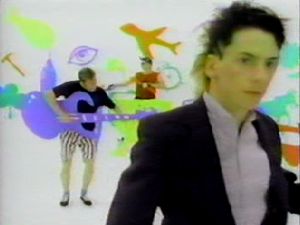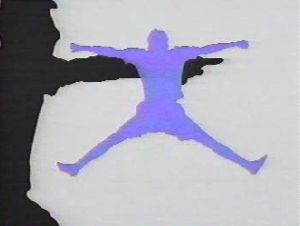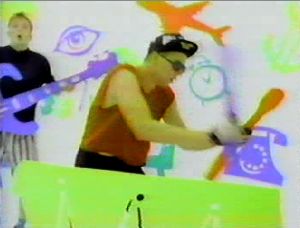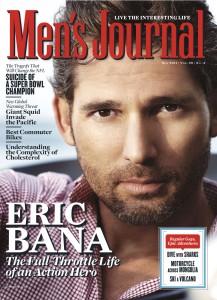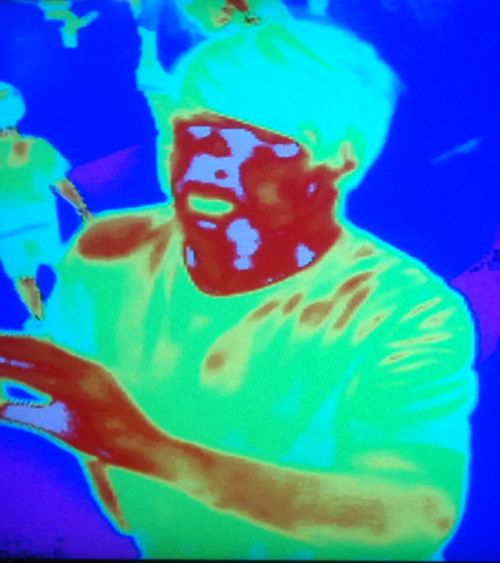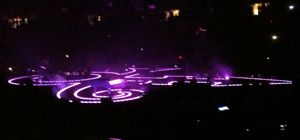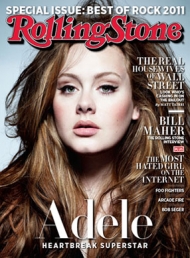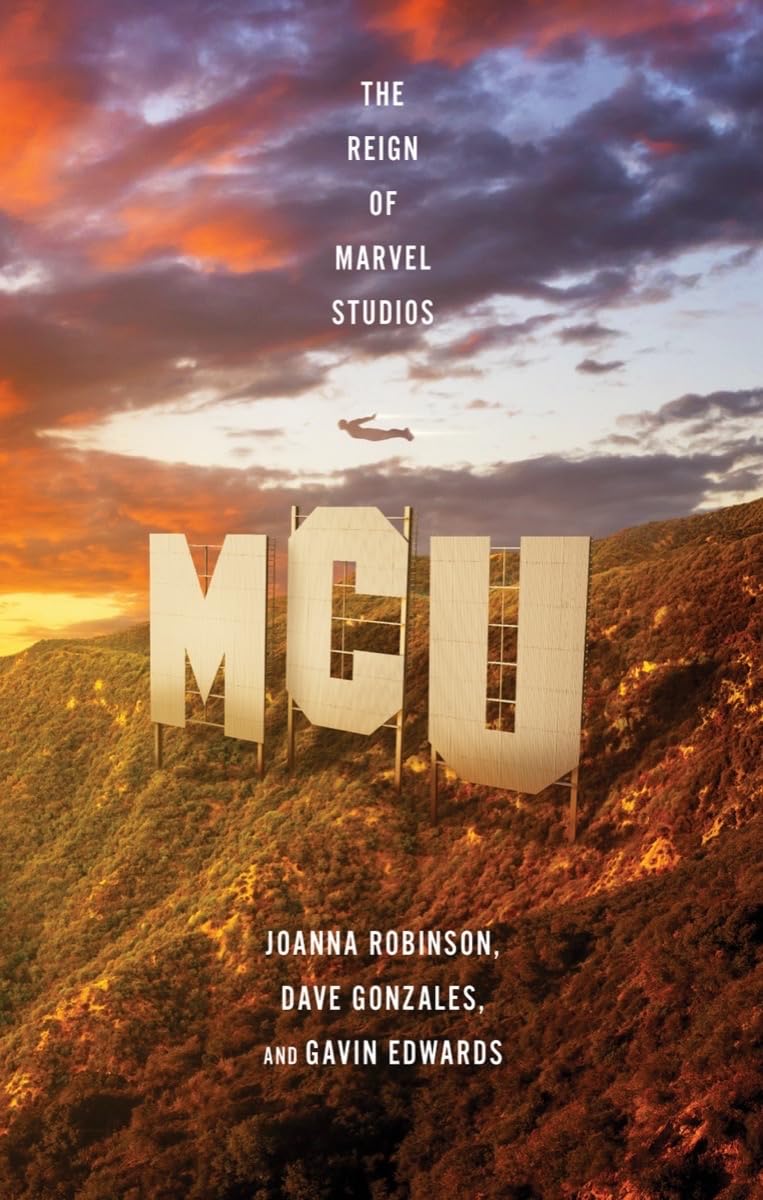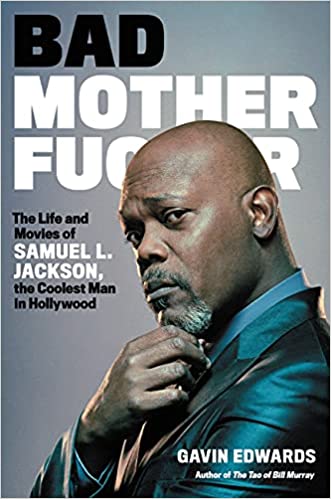(New to the countdown? Catch up here.)
 A burbling drum-machine rhythm accompanies quick cuts of four young white synth-poppers, including a boy with Chris Lowe glasses covering his mouth, a girl with black lace gloves covering her ears, and a lead singer covering one ear and one eye.
A burbling drum-machine rhythm accompanies quick cuts of four young white synth-poppers, including a boy with Chris Lowe glasses covering his mouth, a girl with black lace gloves covering her ears, and a lead singer covering one ear and one eye.
Then a gravelly voice solemnly intones, “Pure energy,” and the set is revealed in its full glory. There’s a white background, with brightly colored scrawls behind the band: an orange airplane, a yellow fish, a green alarm clock. The bassist has an oversized cardboard bass in pastel blue, and is valiantly pretending to play it. It looks sloppy and amateurish, like a high-school drama club took an afternoon to bang out a set for a children’s theater production. It’s not really the image that a hipster synth band wants; this video has the aura of “our A&R rep at the record company told us this would be a good idea.” To add insult to injury, I suspect the band was charged an enormous sum to make this clip.
 We see bright flashing colors, and the words “PURE ENERGY” scrawled across the screen, followed by some black skulls. Lead singer Kurt Harland stalks around the cartoonish set. He’s wearing a black suit and a mod shirt that gestures at the idea of a collar. His hair is a patchwork of black, red, and blonde dye and appears to have a small colony of Spanish moss growing out of one side. He’s trying to look menacing and mysterious, and completely failing.
We see bright flashing colors, and the words “PURE ENERGY” scrawled across the screen, followed by some black skulls. Lead singer Kurt Harland stalks around the cartoonish set. He’s wearing a black suit and a mod shirt that gestures at the idea of a collar. His hair is a patchwork of black, red, and blonde dye and appears to have a small colony of Spanish moss growing out of one side. He’s trying to look menacing and mysterious, and completely failing.
Harland backs away from the camera, holding up fingers counting down–four, three, two, one–and then charges forward and sings “Here I am in silence,” which is an odd first line for a song. Shouldn’t it be “Now I break my silence”? In the background, the girl saws away on a bright blue cardboard violin. The whole band looks like they’re working the acne/concealer combo.
I suppose this is a good place to mention that I vaguely knew Kurt in the early ’90s–he and I were both on the Well, the pioneering online community that over the past two decades has evolved into the Colonial Williamsburg of the Internet. He wasn’t a pal, but we chatted sometimes, and he was a decent enough guy. At the time, he seemed like a rock star who had wandered into a crowd of computer nerds; watching this video now, he looks like a computer nerd who somehow ended up in the same countdown as actual rock stars.
Kurt keeps advancing and retreating, like he’s Grover explaining the difference between “near” and “far.” The other members of the band circle around him. Kurt waves his arms ever more energetically, trying to make up for the charisma deficit. An animated eye blinks. We switch to fast-cut stuttering editing of the band, doing the hands over eyes/ears/mouth bit again. The girl with the oversized cardboard violin is wearing something in her hair that appears to have given her Minnie Mouse ears.
 The band members jump in the air, in brightly colored silhouettes. Beyond a certain altitude, jumping in videos usually looks dorky (e.g., R.E.M.’s “Stand”). Demonstrating this maxim, the drummer jumps up, splayed out like a starfish, with a bicycle cap, high-top sneakers, and a sleeveless t-shirt riding over his belly.
The band members jump in the air, in brightly colored silhouettes. Beyond a certain altitude, jumping in videos usually looks dorky (e.g., R.E.M.’s “Stand”). Demonstrating this maxim, the drummer jumps up, splayed out like a starfish, with a bicycle cap, high-top sneakers, and a sleeveless t-shirt riding over his belly.
More silhouettes, this time of a hammer, to the clanking beat of the song. The drummer appears with a giant orange hammer and bops Harland on the head; Harland lurches backwards, miming a colossal blow. The footage speeds up, as if the editor got bored and fell asleep on the fast-forward button.
Once again, that gravelly voice says “pure energy.” To be more precise, it’s Leonard Nimoy, performing as Spock. Information Society’s schtick (other than being a white band on hip-hop label Tommy Boy) was that their songs included lots of Star Trek samples. These would have been pretty much impossible to clear, if not for the fact that Nimoy’s son was a fan of the band.
 Double-time buzzing riff, as the band cavorts in forced gaiety. The bassist is wearing striped shorts and running around; the girl with the cardboard violin is skipping. Information Society managed another top-ten hit in 1989 (“Walking Away”) and a top-thirty hit in 1990 (“Think”) before disappearing. Apparently, they later tried to reinvent themselves in an industrial mode, which was the synth-pop equivalent of hair-metal bands going grunge. Video aside, this is a decent song. I mean, it’s no “Unbelievable” by EMF, but what is?
Double-time buzzing riff, as the band cavorts in forced gaiety. The bassist is wearing striped shorts and running around; the girl with the cardboard violin is skipping. Information Society managed another top-ten hit in 1989 (“Walking Away”) and a top-thirty hit in 1990 (“Think”) before disappearing. Apparently, they later tried to reinvent themselves in an industrial mode, which was the synth-pop equivalent of hair-metal bands going grunge. Video aside, this is a decent song. I mean, it’s no “Unbelievable” by EMF, but what is?
“What’s On Your Mind (Pure Energy)” hit number three on the singles chart. You can watch it here.
posted 4 May 2011 in 1988. 9 comments
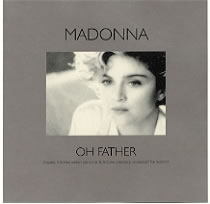 Chris’s comments about Madonna’s chart history, and how her incredible run of top-five singles was interrupted by “Oh Father,” got me thinking about how she never actually released “Into the Groove” as an American single, even though it was everybody’s favorite Madonna song circa 1985 and (I feel confident) would have hit #1. Which then got me wondering: what’s the biggest potential hit other acts never released as a single? With Nirvana, I would nominate “On a Plain,” which always sounded like the third-catchiest song on Nevermind to me (after “Teen Spirit” and “Lithium”). Who else left a smash hit on the table?
Chris’s comments about Madonna’s chart history, and how her incredible run of top-five singles was interrupted by “Oh Father,” got me thinking about how she never actually released “Into the Groove” as an American single, even though it was everybody’s favorite Madonna song circa 1985 and (I feel confident) would have hit #1. Which then got me wondering: what’s the biggest potential hit other acts never released as a single? With Nirvana, I would nominate “On a Plain,” which always sounded like the third-catchiest song on Nevermind to me (after “Teen Spirit” and “Lithium”). Who else left a smash hit on the table?
